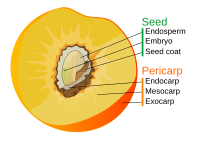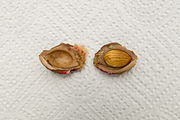
A pyrena or pyrene (commonly called a "pit" or "stone") is the fruitstone within a drupe or drupelet produced by the ossification of the endocarp or lining of the fruit. It consists of a hard endocarp tissue surrounding one or more seeds (also called the "kernel"). The hardened endocarp which constitutes the pyrene provides a protective physical barrier around the seed, shielding it from pathogens and herbivory.
While many drupes are monopyrenous, containing only one pyrene, pome-type fruit with a hard, stony (rather than leathery) endocarp are typically polypyrenous drupes, containing multiple pyrenes.
Development
The hardening of the endocarp of a developing drupe occurs via secondary cell wall formation and lignification. The biopolymer lignin, also found in wood, provides a structure within secondary cell walls which supports the polymerisation of cellulose and hemicellulose; together these polymers provide the endocarp with tensile strength and stiffness. Further hardening occurs during the biomineralisation of the endocarp. The biomineralisation of pyrenes during the life of the plant can aid the preservation of fruit remains in archaeological findings.
Gallery
-
 Cross-section of a peach, a monopyrenous drupe, cut to reveal the pyrene inside
Cross-section of a peach, a monopyrenous drupe, cut to reveal the pyrene inside
-
 Pyrene of a peach dissected to reveal a single seed inside
Pyrene of a peach dissected to reveal a single seed inside
-
 Pyrenes extracted from a single fruit of Crataegus punctata, a polypyrenous drupe
Pyrenes extracted from a single fruit of Crataegus punctata, a polypyrenous drupe
-
 X-ray of a pyrene of Elaeocarpus ganitrus revealing 10 seed-bearing locules inside; the number of locules in E. ganitrus pyrenes is variable between individual fruits
X-ray of a pyrene of Elaeocarpus ganitrus revealing 10 seed-bearing locules inside; the number of locules in E. ganitrus pyrenes is variable between individual fruits
See also
References
- Eckel (2011).
- Beentje & Williamson (2010).
- Hickey & King (2001).
- ^ Dardick & Callahan (2014).
- Potter et al. (2007).
- Allué et al. (2015).
- Messager et al. (2010).
Bibliography
- Allué, Ethel; Cáceres, Isabel; Expósito, Isabel; Canals, Antoni; Rodríguez, Anna; Rosell, Jordi; Bermúdez de Castro, José María; Carbonell, Eudald (2015). "Celtis remains from the Lower Pleistocene of Gran Dolina, Atapuerca (Burgos, Spain)". Journal of Archaeological Science. 53: 570–577. Bibcode:2015JArSc..53..570A. doi:10.1016/j.jas.2014.11.016.
- Beentje, H.; Williamson, J. (2010). The Kew Plant Glossary: an Illustrated Dictionary of Plant Terms. Royal Botanic Gardens, Kew: Kew Publishing.
- Dardick, Chris; Callahan, Ann M. (2014). "Evolution of the fruit endocarp: molecular mechanisms underlying adaptations in seed protection and dispersal strategies". Frontiers in Plant Science. 5: 284. doi:10.3389/fpls.2014.00284. ISSN 1664-462X. PMC 4070412. PMID 25009543.
- Eckel, P.M. (2011). "A Grammatical Dictionary of Botanical Latin". Missouri Botanical Garden.
- Hickey, M.; King, C. (2001). The Cambridge Illustrated Glossary of Botanical Terms. Cambridge University Press.
- Messager, Erwan; Badou, Aïcha; Fröhlich, François; Deniaux, Brigitte; Lordkipanidze, David; Voinchet, Pierre (2010). "Fruit and seed biomineralization and its effect on preservation" (PDF). Archaeological and Anthropological Sciences. 2 (1): 25–34. Bibcode:2010ArAnS...2...25M. doi:10.1007/s12520-010-0024-1. S2CID 128691588.
- Potter, D.; Eriksson, T.; Evans, R.C.; Oh, S.; Smedmark, J.E.E.; Morgan, D.R.; Kerr, M.; Robertson, K.R.; Arsenault, M.; Dickinson, T.A.; Campbell, C.S. (2007). "Phylogeny and classification of Rosaceae". Plant Systematics and Evolution. 266 (1–2): 5–43. Bibcode:2007PSyEv.266....5P. doi:10.1007/s00606-007-0539-9. S2CID 16578516.
| Botany | |||||||||||
|---|---|---|---|---|---|---|---|---|---|---|---|
| Subdisciplines | |||||||||||
| Plant groups | |||||||||||
| Plant anatomy |
| ||||||||||
| Plant physiology Materials | |||||||||||
| Plant growth and habit | |||||||||||
| Reproduction | |||||||||||
| Plant taxonomy | |||||||||||
| Practice | |||||||||||
| |||||||||||